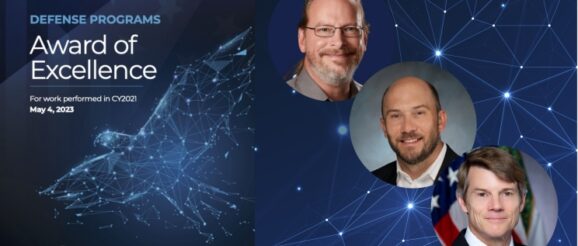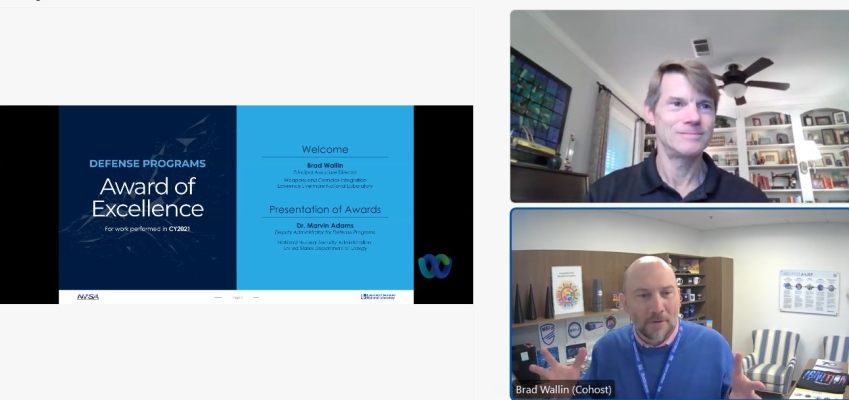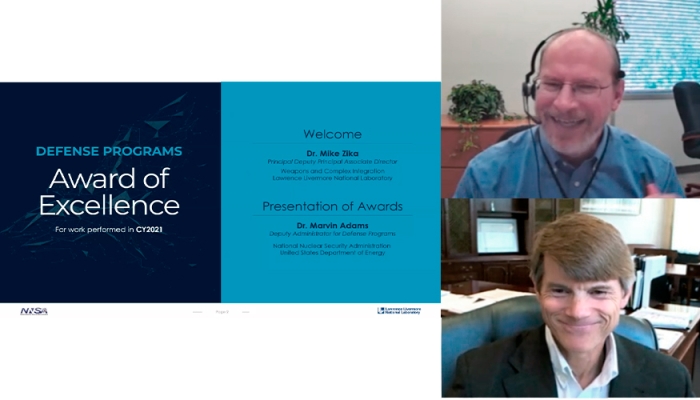Defense Programs Awards of Excellence recognize innovation and achievements in 2021

In virtual ceremonies held May 4 and June 26, Marvin Adams, deputy administrator for Defense Programs at the National Nuclear Security Administration (NNSA), honored individuals and teams at Lawrence Livermore National Laboratory (LLNL) and partner sites for their outstanding contributions to nuclear security. The Defense Programs Awards of Excellence recognition events highlighted the remarkable achievements and innovation displayed of nearly 500 LLNL staff members.
The awards, established in 1982, are bestowed annually to recognize significant individual and team accomplishments in quality, productivity, cost savings, safety, and creativity within the NNSA’s nuclear weapons program. The accolades aim to honor and appreciate the diligent efforts and remarkable contributions of staff at NNSA labs, plants, and sites.
Eight LLNL teams were recognized, and one individual honor presented, encompassing a wide range of impactful contributions to nuclear security. One team, the Polymer Enclave team, was presented with NNSA’s prestigious Exceptional Achievement Award.
“We celebrate each award recipient for their unwavering commitment to excellence and their significant impact on nuclear security,” Adams said. “The Defense Programs Awards of Excellence serve as a testament to the dedication, talent, and innovation within the defense programs community.”
In his opening remarks of the May ceremony, Brad Wallin, principal associate director of the LLNL Weapons and Complex Integration directorate, congratulated honorees.
“By recognizing exceptional achievements and contributions, these awards inspire further progress and motivate individuals and teams to continue pushing the boundaries of excellence in the field of defense programs,” Wallin said.
A recording of the May award ceremony can be viewed here (the June event was not recorded). The following awards are listed in the order they were presented:
Polymer Enclave Team – Exceptional Achievement Award
For significant contributions to standing up the joint Polymer Enclave
The Polymer Enclave Team, consisting of members from LLNL and the Kansas City National Security Campus, has made significant contributions to the establishment of the joint Polymer Enclave facility. After a real-time need to pivot, the redesign, completion of construction, installation of equipment, and conversion were completed in 18 months. This collaborative effort aims to accelerate the realization of the “direct ink write” 3D-printing technology for the nation’s nuclear stockpile. The Polymer Enclave enables faster fulfillment of physics and engineering requirements, as well as enhanced producibility with high-yield and high-rate production capabilities.
LLNL Recipients: Gary Arruda, Tewfik Boutaleb, Taylor Bryson, Lauren Calder, Richard Call, Steve Chan, In Joon Chang, Cameron Cornell, Brian Cotton, Brian Cuan, Chuck Divin, Eric Duoss, Justin Erspamer, Lea Fresques, Veronica Garza, Murad Ghaith, Melody Golobic, Nicholas Gomes, Micha Gresshoff, Steven Guzorek, Jason Hamilton, Adam Jaycox, Jeremy Lenhardt, Hanson Loey, Katy Lu, Alecia Mason, Bob Maxwell, Brad Olson, Reema Ornelas, Lemuel Perez Perez, Karen Pliszka, Matt Rempel, Kenneth Rovasio, Ken Saito, Ibrahim Saleh, Matt Scott, Alex Shapiro, Wallace Singleton, Kevin Streeper, Kim Tan, Todd Weisgraber, Michael Wettig, Tom Wilson, Devon Wirtley, Fangyou Xie, Steven Yep, Teri York, Kelly Youngblood
Cold Hearth Melting of U-6Nb
For demonstration of recycling an alloy production via electron beam cold hearth melting
U-6Nb, or uranium-niobium alloy material, is required for several weapon systems and technology maturation efforts. The team award was presented for demonstration of U-6Nb recycling and alloy production via electron beam cold hearth melting.
The team transferred a technology developed in the 1990s at LLNL to Y-12. The team located new equipment in Oakridge, completed the installation of production-scale cold hearth melting, and performed commissioning and process prove-in using surrogate, non-radiological metals. They then transitioned to radiological activities and melted and cast multiple ingots of the depleted uranium alloy using scrap recycling and direct alloy production – all accomplished within one year. This accomplishment represents a significant advancement toward establishing a capability for recycling U-6Nb material and alloy production.
LLNL Recipients: Tewfik Boutaleb, Kim Budil, Steve Burke, Greg Cabri, Robert E. Haun, Joseph T. Mckeown, Robert H. McKoon, William McLean, Thomas P. Pluschkell, Matt Rempel, Bronson Shelly, Ryan L. Stillwell, Sharon Torres, Derek Wapman, Bradley Wolf, Matt Wraith, Riley Wraith, Amanda S. Wu
W80-4 Porcula Team
For dedication to the Porcula replan and to Catamaran and Sunfish developments
During a time of tremendous scrutiny and scheduling pressure, the LLNL Porcula team overcame numerous obstacles including unforeseen technical delays. The team developed and implemented a baseline (Catamaran) and backup (Sunfish) design of a key component for the W80-4 Life Extension Program, which significantly increased achievability of its First Production Unit.
Both component designs showed incredible creativity and exhibited excellent design, engineering, and programmatic skills. The Catamaran subgroup, in conjunction with the production agency counterparts, crafted an approach to product development that greatly improved the ability to rapidly design, build, and test component cycles. The Sunfish subgroup’s solution satisfied system design requirements for certification and greatly improved the manufacturability of the component. Together, the Porcula team competently created two viable options for evaluation.
LLNL Recipients: Dan Badders, Roger Bopp, Dalton Bradley, Cody Collins, Andrew Cunningham, Steven R. Davis, Lucas A. Dewey, Andrew J. Fowler, Zachary Frohn, Will House, Trevor S. Jolley, Justin T. Jones, Audra Knabenshue, Kenn M. Knittel, Ben Kuyk, Richard Lovoi, Dan S. Manha, Michael McGuire, Abhinav Pradhan, Christopher A. Rider, Tien Roehling, Raymond Ryckman, Ken Saito, Patrick D. Scholl, Fred R. Shaw, Erich V. Shofstall, Benjamin A. Siantar, Thomas M. Simon, Nicholas L. Townsend, Anthony M. Viray, Travis Williams
N210808 Concept, Theory, Design, Shot, Analysis, Laser, and Target Team
For exceeding Lawson’s criterion for Ignition
For more than half a century, researchers around the world have been engaged in efforts to exceed the Lawson’s criterion for nuclear fusion. This is when the fusion heating power is high enough to overcome all the physical processes that cool it, creating a positive thermodynamic feedback loop with rapidly increasing temperature and ultimately, energy gain.
On Aug. 8, 2021, a team at LLNL achieved target gain 0.72 (1.37 MJ of fusion for 1.92 MJ of laser energy delivered to the hohlraum) and capsule gain 5.8 (1.37 MJ for 236 kJ of x-ray energy absorbed). This shot reached ignition by nine different formulations of the Lawson criterion—a monumental achievement that made way for the December 5, 2022, shot that met the 1997 definition of ignition (unity target gain) by the National Academy of Sciences.
Exceeding Lawson’s Criterion for fusion ignition was made possible by teams of multidisciplinary experts in many areas, including target physics, target diagnostics, target fabrication, and the National Ignition Facility laser.
LLNL Recipients: Suzanne Ali, Peter A. Amendt, Jay Ayers, Shannon Ayers, Benjamin Bachmann, Dave S. Bailey, Kevin L. Baker, David Barker, Maria Barrios, Perry M. Bell, Mikhail A. Belyaev, L. Robin Benedetti, Richard L. Berger, Riccardo Betti, Suhas D. Bhandarkar, Juergen Biener, Richard M. Bionta, Noah Birge, Essex J. Bond, Mark Bowers, David K. Bradley, Tom Braun, Richard Briggs, Travis M. Briggs, Matt W. Bruhn, Debra A. Callahan, Arthur C. Carpenter, Jorge Carrera, Daniel T. Casey, Peter M. Celliers, Britton Chang, Tom D. Chapman, Isaac Chavez, Hui Chen, Chris Choate, Alison R. Christopherson, Daniel S. Clark, Jay Crippen, Philip Datte, Matthew Dayton, Eduard L. Dewald, Jean-Michel Di Nicola, Thomas R. Dittrich, Tilo Doeppner, Maylis Dozieres, Laurent Divol, Tony Dymoke- Bradshaw, Mark Eckart, M. John Edwards, Bob Ehrlich, William A. Farmer, Michael Farrell, Valerie Fatherley, John E. Field, David N. Fittinghoff, Johan A. Frenje, Jim A. Gaffney, Hermann Geppert-Kleinrath, Verena Geppert-Kleinrath, Steven M. Glenn, Brad Golick, Gary P. Grim, Steven W. Haan, Kelly D. Hahn, Gareth N. Hall, Bruce A. Hammel, Jonathan Hares, Dana Hargrove, Judy A. Harte, Edward P. Hartouni, Nicholas Hash, Robert Hatarik, John E. Heebner, Vincent J. Hernandez, Hans Herrmann, Mark Herrmann, Terance Hilsabeck, Denise E. Hinkel, Darwin Ho, Matthias Hohenberger, Joe P. Holder, Laura F. Berzak Hopkins, Warren W. Hsing, Kelli D. Humbird, Omar A. Hurricane, Nobuhiko Izumi, Charlie Jarrott, Justin S. Jeet, Maria Gatu Johnson, Ogden S. Jones, Daniel Kalantar, Gary D. Kerbel, Shaun M. Kerr, Shahab F. Khan, Joseph D. Kilkenny, Yongho Kim, John L. Kline, Casey Kong, Joe M. Koning, Bernard Kozioziemski, Andrea L. Kritcher, Jeremy J. Kroll, Michael Kruse, Bogdan Kustowski, Otto L. Landen, Steve H. Langer, Doug W. Larson, Hai L. Le, Nuno R. C. Lemos, Sebastien LePape, John D. Lindl, Michael J. MacDonald, Brian J. MacGowan, Andrew J. Mackinnon, Stephan A. MacLaren, Andrew G. MacPhee, Marty M. Marinak, Christine Mariscal, Derek A. Mariscal, Edward V. Marley, David Martinez, Laurent P. Masse, Kevin D. Meaney, Nathan B. Meezan, Ryan Merrithew, Pierre A. Michel, Marius A. Millot, Jose L. Milovich, John D. Moody, Alastair S. Moore, David Munro, Sabrina R. Nagel, Katya B. Newman, Abbas Nikroo, Ryan C. Nora, Arthur E. Pak, Nathan Palmer, Mehul V. Patel, Prav K. Patel, Lawrence J. Pelz, Jayson Peterson, Richard D. Petrasso, Louisa A. Pickworth, Yuan Ping, Bradley Pollock, Joseph E. Ralph, Neal Rice, Hans G. Rinderknecht, Harry F. Robey, Mordecai D. Rosen, J. Steven Ross, Michael S. Rubery, Jay D. Salmonson, James D. Sater, Dave J. Schlossberg, Marilyn B. Schneider, Chris R. Schroeder, Howard A. Scott, Scott M. Sepke, Kevin Sequoia, Swanee Shin, Nick Shingleton, Vladimir A. Smalyuk, Ricky Sommers, Brian K. Spears, Paul T. Springer, Michael Stadermann, Stanislav Stoupin, David J. Strozzi, Larry J. Suter, George Swadling, Lee A. Taylor, Avi Thomas, Cliff A. Thomas, Keenan Thomas, Nathaniel B. Thompson, Riccardo Tommasini, Richard P. J. Town, Clement Trosseille, Eleanor R. Tubman, David P. Turnbull, Bruno M. Van Wonterghem, Petr L. Volegov, Christopher Walsh, Cory Waltz, Christopher R. Weber, Klaus Widmann, Christoph Wild, Scott Winters, Todd Wooddy, Douglas T. Woods, Brandon N. Woodworth, Steven T. Yang, Charles Yeamans, Christopher V. Young, George B. Zimmerman, Alex B. Zylstra
Individual Award Honoring Ivan Otero
For work on the U.S./France Mutual Defense Agreement
Ivan Otero received the prestigious individual award for his contributions and dedication to the success of collaborations under the U.S./France Mutual Defense Agreement.
ZEUS Neutron Source Team
This joint award was nominated directly by the NNSA program manager and was for work during calendar year 2020.
The ZEUS Neutron Source Team was recognized for the fast and creative development of the ZEUS neutron source within unique restrictions imposed by operation in the U1a facility.
The Z-pinch Experimental Underground System, also known as ZEUS, Neutron Source Team is comprised of members from LLNL, the Nevada National Security Site, and Savannah River National Laboratory. The cross-institutional team made a remarkable contribution to the defense program’s mission by designing, assembling, and testing the new, short-pulse, high-yield ZEUS neutron source to enable reactivity measurements on planned, dynamic, subcritical experiments at the underground facility U1a in Nevada. In less than two years, they were able to implement testing at U1a, which represents a major step toward establishing a new subcritical experiment measurement technique to support the current and future stockpile.
LLNL Recipients: Fred Allen, Rick Anaya, Michael Anderson, Steve Chapman, Ed Koh, Don Max, Andréa Schmidt, Kurt Walters
National Security Experiments at the High-Pressure Collaborative Access Team Facility
For the development and execution of a classified experimental capability at the Advanced Photon Source
The team consisting of staff from numerous groups and departments at Argonne National Laboratory and LLNL, worked jointly in establishing operational safety-security infrastructure, material transfer protocols, and successful execution of a set of experiments at the High-Pressure Collaborative Access Team (HPCAT) facility. HPCAT, which is part of the DOE Basic Energy Sciences operated Advanced Photon Source (APS) facility, provides an array of cutting-edge techniques for studying materials under extreme pressure-temperature conditions.
Due to the mission critical need in completing the DOE-NNSA FY21 Level 2 milestone, staff from HPCAT and LLNL worked closely with APS and various Argonne National Lab groups to develop and implement several experimental options (from open to isolated to fully secure mode). The team worked through safety, security, shipping, experimental design, and various other aspects under COVID work restrictions.
While the experimental measurements provide critical data supporting model development and code validation, the established infrastructure and protocols are robust and available for future support of national security research by NNSA programs, including additional milestones that were scheduled in FY22 and FY23. Execution of these classes of experiments highlight the future opportunities for mission related work at the APS.
LLNL Recipients: Nathan Barton, Nolan Bernal, Hyunchae Cynn, Dayne Fratanduono, Will Evans, Sony Jacob, Zsolt Jenei, Earl O’Bannon, Daniel Sneed, Ricky Sood, Nenad Velisavljevic (HPCAT)
Plutonium and Pit Aging Program
For the development, planning, and execution of elements of the decadal Plutonium/Pit Aging plan submitted to Congress
In the spring and summer of 2021, NNSA federal program managers worked closely with lab partners to draft a classified report on the topic of plutonium and pit aging. The team exceeded expectations in their work with federal leads to put forward a comprehensive decadal view outlining a series of work supporting program milestones, facility/capability needs, and associated budget estimates.
The classified report was completed while under constraints of COVID operations and outlined a cross-program view primarily centered on R&D equities. The report has been instrumental as a communication tool with both internal and external stakeholders to articulate a comprehensive, overarching view of the topic, and it identifies acceleration of R&D opportunities and current gaps.
LLNL Recipients: Tom Arsenlis, Teresa Bailey, Nathan Barton, Dayne Fratanduono, Hector Lorenzana
Red Sage-Nightshade Subcritical Experiment Team
For successfully executing three subcritical experiments in less than a year
The Red Sage-Nightshade Team applied their unique scientific, engineering, technology, and operations expertise to successfully execute three subcritical experiments in a period of less than eleven months between November 2020 and September 2021. To provide context for this remarkable achievement in productivity, NNSA executed seven subcritical experiments in the 2010 decade.
Conducting subcritical experiments is a complex endeavor requiring a large, multi-disciplinary, integrated team from Los Alamos National Laboratory, the Nevada National Security Site, Sandia National Laboratories and LLNL. The team was required to overcome numerous challenges during this period to accomplish a remarkable SCE execution rate very rarely achieved in the history of the SCE Program. A few especially notable examples of these challenges were: adapting to ensure safe execution and quality data return when a plutonium target became dislodged from its intended position; and coordinated schedule deconfliction with the U1a Complex Enhancement Project to not adversely impact progress on implementing new capabilities in the U1a facility.
The data generated by these subcritical experiments addresses key gaps in our predictive capability for primary performance and will be used to underwrite the future U.S. stockpile.
LLNL Recipients: Jesse Adams, Andrea Albert, Valorie A. Allison, Allen D. Allshouse, Travis Alvey, Victoria M. Anders, Thomas D. Augustine, Amy Bauer, Corey E. Bishop, Adam D. Bellflower, Christopher W. Bolejack, Jesse Bonner, Donald M. Bourcier, Taren Bowen, Sean Breckling, Tyler Bronson, Dale J. Brush, Joanne L. Budzien, Dilhan Bulegoda, John P. Butler, Warren Canning, Lorraine Capitanelli, Charlotte Carter, Brian Cata, Elijah Chamberlin, Daniel Champion, Manuel E. Chavez, Marissa Christman, Steve Compton, Brian Conway, Jeffrey Culbertson, Chau Dang, Craig S. Cunico, Jeremy Danielson, Leisa B. Davenhall, Nicholas A. Denissen, Christopher Denton, Leonora A. Dillingham, Patrick Dixon, Dana L. Duke, Jeffrey Edlund, Ryan Emmitt, Erika Esquivel, Garrett G. Euler, Louis Ferranti, Jr., Mark Fiscus, Paul Flores, Christen M. Frankle, Stephen S. Fresquez, Bill Fritz, David A. Fry, Jun Gao, Elaine Gallegos, Lucas Gallegos, Michael R. Garcia, Salomon A. Garcia, Mandy Gehring, Robert C. Gentzlinger, Greg Getha, Michael Gibo, Meghan Gibbs, Vincent Gomes, John Gonzales, Robert D. Gonzales, Alan Goodall, David Gubernatis, Todd Haines, Michael Hanace, Wadih Hanache, Mark Hansen, James P. Harding, Alan K. Harrison, Thomas M. Hartsfield, Keith Hogge, Rhonda Hopkins, William N. Hopkinson, Kaleb Howard, Marylesa Howard, Russell Howe, Kyle Hughes, Thomas A. Jachimowski, Andrew Jensen, Mandy Jensen, Kirk Keilholtz, Leslie Kelley, Rand Kelly, John Kiser, Jerry Kole, Scot Krubsack, Lawrence K. Kwei, Morgan J. Lavelle, Jacob Lawrence, Pierre-Yves Le Bas, Mark E. LeDoux, Nicholas P. LeDoux, Stefani Lee, Kevin Love, Margaret Lund, Majlinda Malellari, Ruben Manzanares, Ryan Marelli, Ryan P. McCombe, Kevin McGillivray, Anthony M. Mendez, Samantha Messer, Jacqueline Mirabal-Martinez, Ethan Moll, Matthew Montoya, Nolan Moore, John S. Morris, Matthew M. Murray, Scott Myers, Jeremy M. Nowell, Daniel T. Olive, Russell T. Olson, Brian O’Neil, Eugene Ormond, Trent Otteson, Martin Palagi, Martin Parrales, Michael G. Pastis, Jeremy R. Payton, Bill Peach, Michael Pena, Carlos Perez, Jr., David Phillips, Alison L. Pugmire, Adam Rezek, Jeramie Rick, Boyd Ritter, William G. Robertson, Isaac Robinson, Christopher Romero, Mario Romero, Vincent Romero, Adrien Sanchez, Monica L. Sanchez, Mike Silvia, Bryan T. Sims, Sky K. Sjue, Robert Smalley, Erick Smith, John R. Smith, Michael D. Sonne, Luis Soriano, Danny Sorenson, Charles Spillers, Paul Steele, Thomas Stepan, Jacob Stephenson, Alexander Sudderth, David Swan, Robert W. Sykes, Alexander S. Tafoya, Shawn Taulbee, Jeffrey Taylor, Doug Thacker, Christopher Tiraada, CY Tom, Laura M. Tomlinson, Morgan H. Tompkins, Ian L. Tregillis, Ashley K. Trujillo, Hoai-Tam Truong, John Vargas, Pablo Vazquez, Duane Vigil, Juan-Antonio F. Vigil, Lawrence Vigil, Marty Vigil, Arturo O. Villalobos, David R. Villareal, Todd Ware, Anthony Warren, Brandon White, Wesley S. Wilburn, Ajanae Williams, James L. Wilson, Hasani Omar Wooten, Clifton Wright, Clarissa A. Yablinsky, James M. Yax, Raymond M. Yost, Vincent W. Yuan


